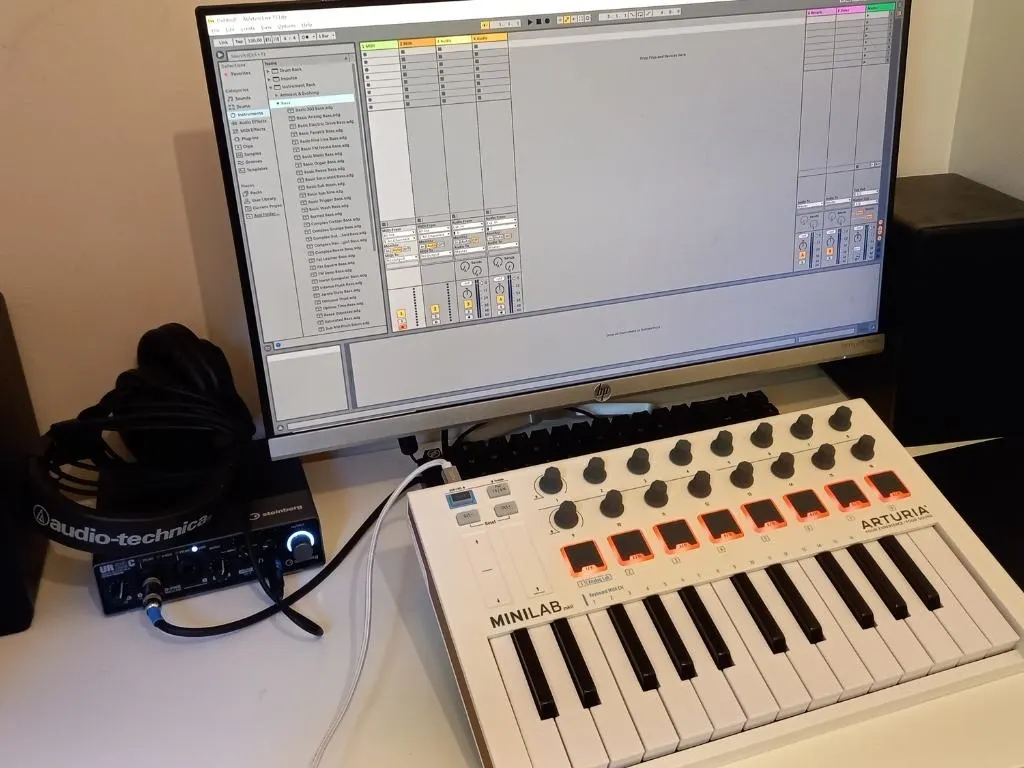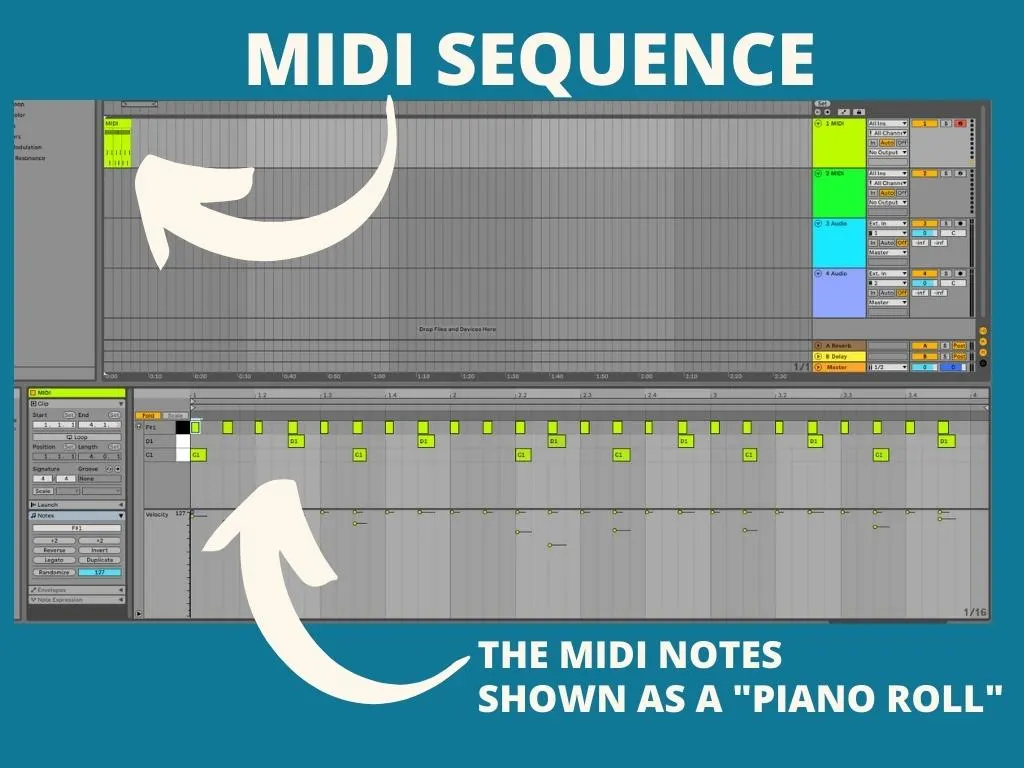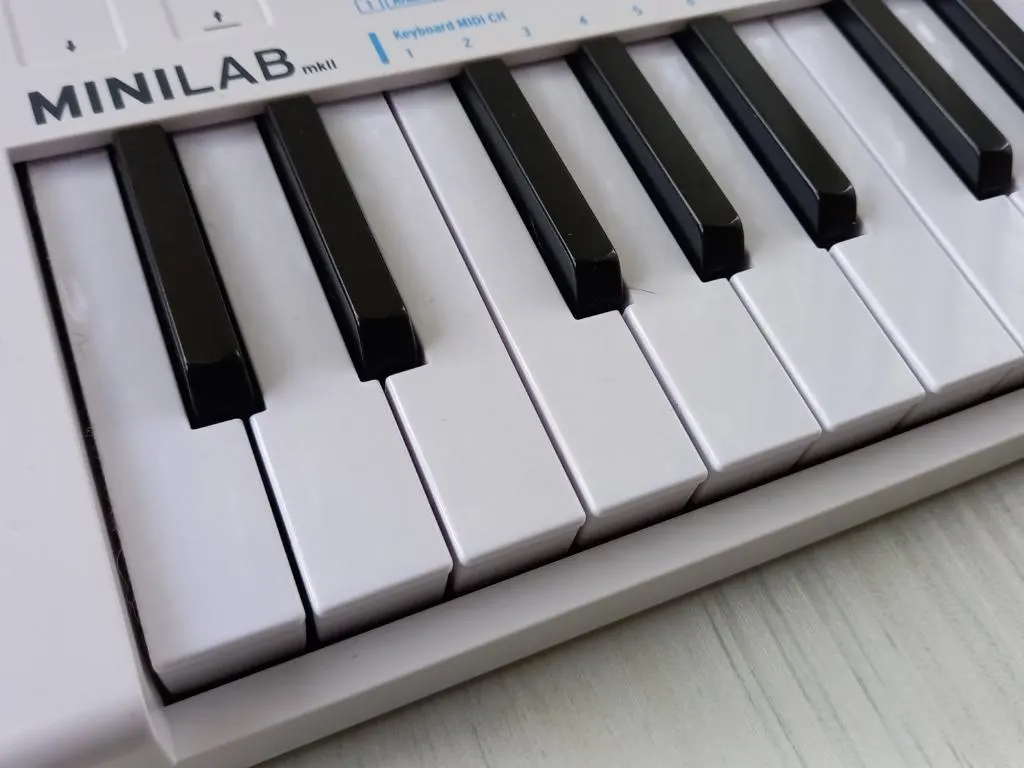If you’re just getting started with music production, you’ve probably heard a lot about “MIDI” and wondered what it’s all about.
I asked myself the same thing back when I first started making music. I had no idea just how essential it was. Since then, I now use MIDI every time I perform, record, and edit music.
Put simply, MIDI is the way that digital music equipment talks to each other. One device sends an instruction, and the other one follows it.
It was originally developed in the 1980s as a standardized way for different gear (mostly synthesizers) to work with each other. Before this, each manufacturer had their own way for equipment to interact with each other. MIDI provided a solution that could be used across any different device, regardless of who made it.
Nowadays, MIDI is used by musicians for a wide range of things. Whether you’re performing live with digital gear or recording in the studio, it’s important to know what MIDI is and how it works, and how to make it work for you.
What is MIDI?
MIDI (short for “Musical Instrument Digital Interface”) is the language that electronic music equipment uses to communicate with each other.
It’s a set of digital instructions (called “MIDI messages”) that’s sent from one device to another, telling the receiving device what to do.
For example, pressing a key on a MIDI keyboard would send a MIDI message to a connected synthesizer, telling it which note to play.
Devices that send MIDI messages are called MIDI controllers. These could be a hardware device, like a MIDI keyboard, or a software device, such as a Digital Audio Workstation (DAW).
In the modern digital age, MIDI has become an essential tool for musicians. It has many different uses, such as:
- Playing and recording virtual instrument and samples
- Remotely controlling a hardware instrument (or multiple instruments)
- Remotely controlling music software (e.g. adjusting settings in a DAW)
- Triggering musical events (e.g. live looping, stage lighting, etc)
How does it work?
MIDI is just a set of instructions that’s sent from one device to another. Whether you’re using a MIDI controller to tell a synthesizer what to play, or adjusting the settings in your DAW to edit a track.
Let’s look at how this works:
- A MIDI controller is connected to a receiving device
- The MIDI controller sends a MIDI message to the device
- The device carries out a function
MIDI controllers
A MIDI controller is a device that can send (and usually receive) MIDI messages. They come in a lot of different designs, with the most common being a MIDI keyboard.
They used to control another device, when connected using either a MIDI cable, USB cable, or even Bluetooth.
The main purpose of a MIDI controller is convenience. They provide you with a simplified and physical way to interact with virtual instruments or complex setups.
The best (and most common) example of this is using a MIDI keyboard to control a virtual instrument on a PC. The keys of the MIDI keyboard tell the instrument what notes to play (and how to play them).

But, it’s not just about playing an instrument. The controls on a MIDI controller can be configured to the gear that you’re using to control the gear that you’re using. For example, you could configure a knob on a MIDI controller to adjust the volume of a track.
In both examples, the MIDI controller replaces the slow and uninspiring process of using a computer mouse to create music!
Think about it: instead of manually inputting individual notes and adjusting settings with a mouse, you can quickly connect a MIDI controller and make music in a much more natural way.
MIDI messages
MIDI messages are the instructions sent from one MIDI device to another. These instructions tell the receiving device what to do.
For example, let’s go back to the example of a MIDI keyboard connected to a synthesizer. Pressing a key on the MIDI keyboard will send the following data:
- Pitch: Which key(s) was pressed
- Velocity: How hard the key(s) was pressed
- Duration: How long the key(s) was held for
This can be used alongside other controls on the device to send additional information, such as:
- Control change (MIDI CC): Changes different settings on the instrument (e.g. pitch bending, adjusting volume, etc)
- Aftertouch: Any additional motions on the key(s) after they’ve been pressed (this is less common on MIDI controllers – especially ones for beginners)
So, the receiving synthesizer will use these instructions to accurately recreate how you “played” your MIDI keyboard.
But, it isn’t just for live performances. MIDI information can also be recorded, which is called “sequencing”.
MIDI sequencing
Unlike traditional audio recordings, which capture a sound, recording a MIDI controller creates a MIDI sequence – which is just a record of the MIDI messages. This MIDI sequence can then be connected to any other device, and it’ll carry out the instructions.
A great example of this is recording a virtual drum track. One way to record a drum track is to use a MIDI controller and use the keys to “finger drum” a pattern.
Personally, I’m not that great at finger drumming. My hands get confused, I mess up, and it ruins my recording. Instead, I can create a MIDI sequence and send it to a virtual drum kit to “play” the drums for me – pretty cool, right?

Companies even create and sell different sequences, called “MIDI packs”. These MIDI packs could be chords, drum patterns, basslines… anything! You just download the pack, load the sequence in your DAW, connect it to the intended instrument, and away you go.
Companies even create and sell different sequences, called “MIDI packs”. These MIDI packs could be chords, drum patterns, basslines… anything! You just download the pack, load the sequence in your DAW, connect it to the intended instrument, and away you go.
What’s it used for?
MIDI is a really versatile tool with a lot of different uses. I can’t overstate just how much it’s used in modern music production.
It touches the entire workflow for making music: from recording, to performing, to mixing and mastering.
It’d be impossible for me to cover everything MIDI can do, because it’s so customizable. Instead, I’ve covered a few common examples of how you can use MIDI in each stage of your workflow.
Recording music
The most common use for MIDI is for recording music, often by using a MIDI keyboard to control a DAW.
Here, the MIDI controller sends instructions to a virtual instrument (or “VSTi”) on the computer which makes a sound. But, it doesn’t have to be a virtual instrument. You can connect a hardware synthesizer and control it using MIDI from your DAW.
When you hit record, you’ll be recording the MIDI sequence (all the MIDI messages sent from your controller) as well as the audio from your VSTi or live instrument.

So, why use MIDI for recording? Because MIDI is really easy to work with. Seriously.
- Played a wrong note? Just change it to the right note in the MIDI sequencer.
- Not been able to keep time? Align your MIDI sequence to the beat by “quantizing” them.
- Don’t like how your recording sounds? Edit your instruments settings, or connect a new instrument, and use the MIDI sequence to play it.
Using MIDI is so much easier than recording traditional instruments. Unlike an audio recording, you can edit pretty much everything afterwards. Just open up the sequencer, make your changes, and send the sequence back to your instrument.
Performing music
MIDI opens up a whole new world of possibilities for performing music. The musician with their laptop on stage? They’re using MIDI. The person stood behind a tower of synthesizers? MIDI. The beat-maker chopping and changing beats live on stage? You guessed it.
There really are countless ways to implement MIDI into a live set up. Depending on what you’re doing, the gear needed will change, too.
Playing virtual instruments
With just a MIDI keyboard and a laptop, you have access to basically any instrument you want. Forget carrying around bulky hardware synthesizers, you can switch between sounds at the click of a button – all on a setup that fits in a backpack!
Just plug your MIDI controller into your laptop, and your laptop into a speaker or PA system, and you’ve got an incredibly versatile library of sounds at your fingertips.
Live looping
Live beat making and looping has grown in popularity lately, championed by artists like Flying Lotus and Marc Rebillet. By synchronizing instruments to a MIDI clock, and triggering them using a MIDI controller, you can create complex beats on the fly.
But, you don’t have to create it from scratch. A lot of live performers trigger different loops of pre-recorded material to perform their songs live.
Controlling multiple live instruments
If you’ve ever seen a live performance from musicians that use hardware synthesizers (think Com Truise or Tobacco), then there’s a good chance that they were controller their hardware from a central unit.
Most of the time, the gear will be connected to a laptop running a DAW. But, you can also control the synthesizers directly with a single MIDI keyboard (although, it’s a bit harder).
Depending on your setup, using MIDI could be a great way to simplify your playing. Instead of darting around to different instruments, you can just stay in one place and change between them at the click of a button.
DJ decks
When we think of DJ’s, our mind usually jumps to people scratching old fashioned vinyls. But times have changed. Most modern DJ’s use MIDI controllers shaped like DJ decks to control DJ software.
These decks send MIDI instructions, allowing DJ’s exactly the same functionality as their old school counterparts, but with a lot less gear to carry round! Instead of boxes and boxes of bulky equipment, it’s just a set of DJ decks, a laptop, and a pair of headphones.
Mixing and mastering
Using a MIDI controller makes mixing music in a DAW a lot faster (based on my experience). By assigning physical knobs and sliders to different settings in your DAW, you can quickly and easily make adjustments without having to use your computer’s mouse.
This makes editing feel a lot more natural and intuitive. It makes your computer feel like part of a music studio, not just a PC.
Using a MIDI controller also allows you to use both of your hands. This might sound like a small benefit, but it really helps when you’re adjusting a lot of settings. The seconds saved really do add up!
Pros and Cons of MIDI
So, now that we know what MIDI is, how it works, and what it’s used for; let’s take a closer look at the advantages and disadvantages of using MIDI in your workflow.
Advantages of MIDI
Speed
The biggest advantage of MIDI is that it can speed up your entire workflow. Using a MIDI controller to control an instrument or adjust settings in your DAW is so much faster (and more natural) than clicking away using a mouse.
Likewise, programming a MIDI sequence using a MIDI controller can get you the perfect performance every time from a virtual instrument or hardware synthesizer.
Accessibility
MIDI makes playing and recording music much more accessible for everyone. If you want to record a drum beat, you don’t need to buy a drum kit and spend years learning the drums: just grab a drum VSTi and tap away on your MIDI controller.
Better yet: program a MIDI sequence and send that to your drum VSTi. No playing needed!
Affordability
There are so many budget friendly MIDI controllers available nowadays, that it makes sense to get one. Connect it to a DAW (which you can pickup for free in some cases), and you can make high-quality music for under $100.
I actually cover my personal recommendation for the best MIDI controller (and the one that I use) for under $100 in this article.
But, using MIDI can also save you money. Synthesizers (especially vintage synths) are very expensive pieces of gear. If you’re just getting started, you probably don’t want to spend all that money. Instead, you can just pick up a MIDI controller and some VSTi’s (again, some you can get for free) and start making music.
Editable
When you record MIDI, you record exactly how you played the notes. So, if you’re not happy with your performance, you can just tweak the notes in the MIDI sequence and make it sound how you want!
It’s an incredibly easy process that’s much more convenient than doing take after take until you get it right.
Small file sizes
MIDI files are really small, especially when compared to bulky audio recordings. If you’re limited on computer storage space, using MIDI instruments might be your best bet.
Not only that, but if you’re collaborating with other musicians – it’s easy to share files. You’re not going to be uploading and downloading a lot of data.
Variety of sounds
Using MIDI (with a DAW) gives you access to countless different instruments. No matter what genre of music you make: you can make it using MIDI.
I’ve heard a metal drummer using a virtual drum kit, and I honestly couldn’t tell! Sure, a good VSTi will cost a bit of money, but it’ll always be cheaper (and smaller!) than the real thing.
Disadvantages of MIDI
Playback issues
MIDI only records instructions, it doesn’t record audio (unless you record the audio from your MIDI instrument).
Remember what I said about sharing files? Well, if the person you’re sharing it with doesn’t have access to the same VSTi’s as you – then they’re not going to be able to get the same sound.
VSTi instrument sound quality
VSTi’s can be hit or miss in terms of quality. As a general rule, the cheaper it is, the less real it will sound. This isn’t always a bad thing. Some people look for an artificial sound.
But, tone purists may have to spend a bit of money to get the sound they’re looking for.
Top tip: If you’re looking to buy a MIDI controller – some come with licences for additional DAW software. This could save you money, and give you some good VSTi’s to get you started.
Can’t record vocals
MIDI can’t be used to record vocals. It makes sense, if you think about it. Vocals contain so many different variations in pitch, length, tone… it’d take a lot of computing power to replicate a vocal that sounded just like you.
This isn’t a problem for everyone. MIDI can still play an important part in recording and performing vocals, such as adjusting the level of effects. You just can’t record the vocals themselves.
CPU heavy
Working with multiple MIDI instruments and plugins takes its toll on your PC. I don’t know about you, but my PC isn’t the best in terms of computing power. When I load up a few plugins and instruments, I quickly reach my CPU’s maximum capacity.
So, if you’re looking to use all MIDI instruments – or want a reliable stream of MIDI when playing live – you’re going to need a computer that’s up to scratch (usually an i5 processor or higher).
Summary
MIDI first appeared in the 1980s, and has gone on to form the backbone of modern music production practices.
One thing that I hope has come across in this article is just how much MIDI can change your workflow for the better. Whether you’re performing, recording, or mixing and mastering – there’s definitely a place for MIDI to make your workflow easier, more intuitive, and more fun.
No one wants to sit down and make music with a computer mouse. Grab a MIDI controller, and start having fun with making music!

Conor is a music producer, multi-instrumentalist, and all-round enthusiast from the UK with over 15 years of experience. He’s the founder and sole-content creator for the roundtable audio blog and YouTube channel.
